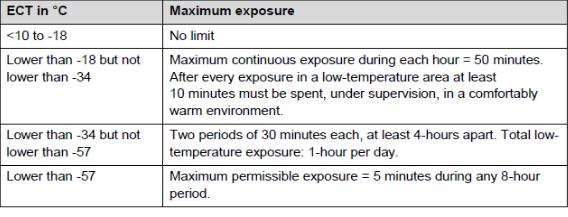
As South Africa experiences increasingly unpredictable weather patterns, the risks associated with thermal stress in the workplace are becoming more relevant—especially for outdoor workers, those in refrigerated environments, and employees in high-altitude or rural areas. Cold stress occurs when the body loses heat faster than it can produce it, leading to health complications such as hypothermia, frostbite, and trench foot.
While often overshadowed by heat-related illnesses in the African context, cold stress is a real and growing occupational hazard.
Understanding thermal stress, its symptoms, and how to prevent it is essential for maintaining a safe and healthy workplace, especially in industries where outdoor or refrigerated work is common.
What is Cold Stress?
Cold stress is not a disease in itself but a condition that can lead to serious health outcomes. It typically arises in environments where temperatures are low, especially when combined with wind, dampness, or inadequate clothing. The most common cold-related illnesses include:
- Hypothermia: A dangerous drop in core body temperature.
- Frostbite: Freezing of skin and underlying tissues, often affecting extremities.
- Trench Foot: Caused by prolonged exposure to wet and cold conditions.
These conditions can impair physical and cognitive function, increasing the risk of accidents and long-term disability.
Recognizing the Signs
Early recognition of thermal stress symptoms is crucial. Employers and coworkers should be trained to identify the following warning signs:
- Uncontrollable shivering
- Slurred speech
- Clumsiness or lack of coordination
- Confusion or drowsiness
- Pale, cold, or waxy skin
- Numbness in extremities
Prevention Strategies
Preventing cold stress requires a combination of environmental controls, proper clothing, and worker education. Here are key strategies:
Engineering Controls
Use radiant heaters or windbreaks in outdoor work areas.
Provide heated shelters for breaks.
Administrative Controls
Schedule work during the warmest part of the day.
Rotate workers to limit exposure time.
Monitor weather conditions and adjust work plans accordingly.
Train workers on cold stress risks and first aid.
Personal Protective Equipment (PPE)
Provide layered clothing that can be adjusted based on activity level and weather.
Ensure clothing is waterproof and wind-resistant.
Supply insulated gloves, hats, and boots.
Encourage workers to keep dry and change out of wet clothing promptly.
Legal & Regulatory Considerations and the Role of Employers
In many countries, employers are legally obligated to provide a safe working environment, which includes protection from cold stress.
For example, in South Africa The Occupational Health and Safety Act (OHSA) mandates that employers provide and maintain a work environment that is safe and without risk to the health of employees.
The newly promulgated Physical Agents Regulations, 2024 requires that where it is not reasonably practicable to eliminate cold stress at source and exposures are at or below the Occupational Exposure Limit (OEL) of 10°C the employer or self-employed person must, as a minimum
- Implement alternative working methods to reduce exposure to cold stress
- Install plant and machinery designed to reduce the risk of thermal stress and implement maintenance programmes for the plant and machinery.
- Conducting risk assessments
- Providing appropriate PPE
- Training employees on thermal stress awareness
- Monitoring workers for signs of cold-related illnesses
- Limit the duration and magnitude of exposure of employees such as to not exceed the periods as stipulated in Table 1:
Table 1: Cold Stress exposure period
Conclusion
Cold stress may not be the most obvious occupational hazard in South Africa, but it is a real and growing concern, especially in the context of climate variability and expanding industrial sectors. By understanding the legal framework, recognizing the symptoms, and implementing preventive measures, both employers and employees can work together to ensure safer, healthier workplaces.
References
- Physical Agents Regulations, 2024
- Judiciary of South Africa. (2025). 2025 Judgments – Labour Court. Retrieved from https://www.judiciary.org.za
- Commission for Conciliation, Mediation and Arbitration (CCMA). (2021). Compensation for Occupational Injuries and Diseases Act (COIDA) Info Sheet. Retrieved from https://www.ccma.org.za
- National Institute for Occupational Health (NIOH). (n.d.). Stress in the Workplace. Retrieved from https://www.nioh.ac.za









